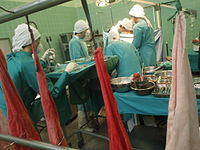
Photo from wikipedia
Kartagener syndrome (KS) is a rare congenital disorder related to bronchiectasis, chronic sinusitis, and situs inversus, predisposing patients to recurrent respiratory infections that can evolve to end-stage lung disease; lung… Click to show full abstract
Kartagener syndrome (KS) is a rare congenital disorder related to bronchiectasis, chronic sinusitis, and situs inversus, predisposing patients to recurrent respiratory infections that can evolve to end-stage lung disease; lung transplantation (LTx) is one of the therapeutic options. This study highlights some concerns in this group of patients, mainly related to the difficulty of performing the transplantation in recipients with suppurative disease and situs inversus. We conducted a retrospective analysis of all KS patients who underwent LTx at 2 national reference centers by the same LTx team. During 29 years of analysis, we performed 12 cases of bilateral sequential LTx in KS patients, representing 2.4% of all Ltx that we performed. Special perioperative care is needed, including vascular access sites and lung isolation techniques; operative concerns include the arteriotomy and bronchotomy during the back table preparation of the graft and concern about the length of the arterial and bronchial anastomosis. We found a higher incidence of bronchial complications is this group that had not been previously reported. Bilateral sequential orthotopic LTx is feasible in this group of patients, and more studies are needed to understand possible reasons for the apparent higher incidence of bronchial complications.
Journal Title: Transplantation proceedings
Year Published: 2020
Link to full text (if available)
Share on Social Media: Sign Up to like & get
recommendations!